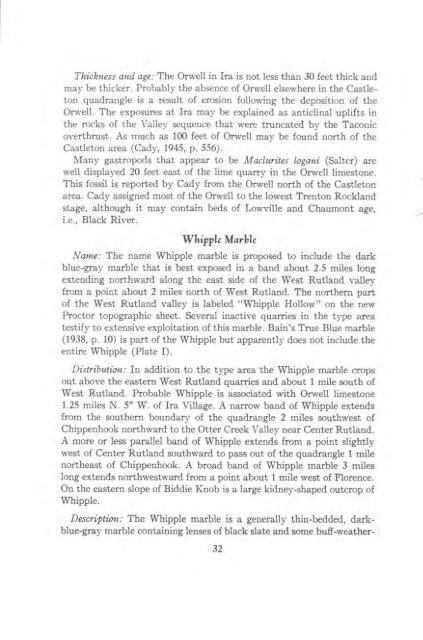STRATIGRAPHY AND STRUCTURE CASTLETON AREA VERMONT
STRATIGRAPHY AND STRUCTURE CASTLETON AREA VERMONT
STRATIGRAPHY AND STRUCTURE CASTLETON AREA VERMONT
Create successful ePaper yourself
Turn your PDF publications into a flip-book with our unique Google optimized e-Paper software.
Thickness and age: The Orwell in Ira is not less than 30 feet thick and<br />
may be thicker. Probably the absence of Orwell elsewhere in the Castleton<br />
quadrangle is a result of erosion following the deposition of the<br />
Orwell. The exposures at Ira may be explained as anticlinal uplifts in<br />
the rocks of the Valley sequence that were truncated by the Taconic<br />
overthnist. As much as 100 feet of Orwell may be found north of the<br />
Castleton area (Cady, 1945, p. 556).<br />
Many gastropods that appear to be Maclurites logani (Salter) are<br />
well displayed 20 feet east of the lime quarry in the Orwell limestone.<br />
This fossil is reported by Cady from the Orwell north of the Castleton<br />
area. Cady assigned most of the Orwell to the lowest Trenton Rockland<br />
stage, although it may contain beds of Lowville and Chaumont age,<br />
i.e., Black River.<br />
Whpple Marble<br />
Name: The name Whipple marble is proposed to include the dark<br />
blue-gray marble that is best exposed in a band about 2.5 miles long<br />
extending northward along the east side of the West Rutland valley<br />
from a point about 2 miles north of West Rutland. The northern part<br />
of the West Rutland valley is labeled "Whipple Hollow" on the new<br />
Proctor topographic sheet. Several inactive quarries in the type area<br />
testify to extensive exploitation of this marble. Bain's True Blue marble<br />
(1938, p. 10) is part of the Whipple but apparently does not include the<br />
entire Whipple (Plate I).<br />
Distribution: In addition to the type area the Whipple marble crops<br />
out above the eastern West Rutland quarries and about 1 mile south of<br />
West Rutland. Probable Whipple is associated with Orwell limestone<br />
1.25 miles N. 50 W. of Ira Village. A narrow band of Whipple extends<br />
from the southern boundary of the quadrangle 2 miles southwest of<br />
Chippenhook northward to the Otter Creek Valley near Center Rutland.<br />
A more or less parallel band of Whipple extends from a point slightly<br />
west of Center Rutland southward to pass out of the quadrangle 1 mile<br />
northeast of Chippenhook. A broad band of Whipple marble 3 miles<br />
long extends northwestward from a point about 1 mile west of Florence.<br />
On the eastern slope of Biddie Knob is a large kidney-shaped outcrop of<br />
Whipple.<br />
Description: The Whipple marble is a generally thin-bedded, darkblue-gray<br />
marble containing lenses of black slate and some buff-weather-<br />
32













